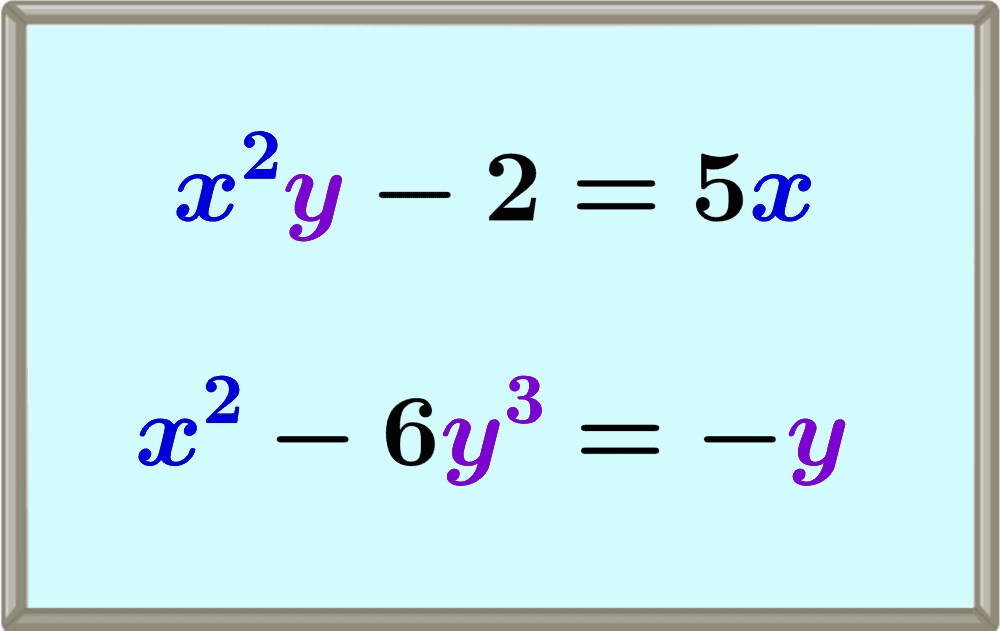Implicit functions can be differentiated by deriving each term of the function with respect to x. For this, the chain and product rules are often used. Then, the obtained equation is solved for dy/dx.
In this article, we will solve several exercises of derivatives of implicit functions. In addition, we will look at some practice problems.
How to do implicit differentiation?
Recall that implicit functions are functions that are not expressed in the form $latex y=f(x)$. For example, $latex x^2+2xy=5$ is an implicit function.
In some cases, we can rearrange the implicit function to obtain an explicit function of $latex x$. For example, $latex x^2+2xy=5$ can be written as:
$$y=\frac{5-x^2}{2x}$$
Then, we could derive this function using the quotient rule.
However, in many cases, the implicit function cannot be expressed in the form $latex y=f(x)$, such as the function $latex x^2+3xy-4y^3=7$.
In this case, we can use the following process to derive this type of function:
Consider the following implicit function:
$latex x^2+y^2=2$
Deriving each term with respect to $latex x$, we have:
$$\frac{d}{dx}(x^2)+\frac{d}{dx}(y^2)=\frac{d}{dx}(2)$$
The derivative of $latex x^2$ in terms of $latex x$ is $latex 2x$ and the derivative of 2 is 0, but for the term $latex y^2$, we have to use the chain rule:
$$\frac{d}{dx}(y^2)=\frac{d}{dy}(y^2)\frac{dy}{dx}=2y\frac{dy}{dx}$$
Then, the derivative of the function is:
$$2x+2y\frac{dy}{dx}=0$$
Now, we just have to rearrange for $latex \frac{dy}{dx}$:
$$\frac{dy}{dx}=-\frac{2x}{2y}=-\frac{x}{y}$$
Examples with answers of implicit derivatives
EXAMPLE 1
Find $latex \dfrac{dy}{dx}$ by implicit derivation of:
$$x^2+y^2 =16$$
Solution
Deriving on both sides of the equation:
$$ (x^2+y^2)^{\prime}=(16)^{\prime}$$
$$ (x^2)^{\prime}+(y^2)^{\prime} =(16)^{\prime}$$
Since the derivative of a constant is 0, we have:
$$ 2x+2yy^{\prime} =0$$
Then:
$$ 2x+2yy^{\prime} =0$$
Given that: $latex y^{\prime} =\dfrac{dy}{dx} $, then:
$$ 2x+2y\dfrac{dy}{dx} =0$$
When we isolate the derivative, we obtain:
$$\dfrac{dy}{dx} =-\dfrac{x}{y}$$
EXAMPLE 2
Implicitly derive the following function to find $latex \frac{dy}{dx}$:
$$x^2y=4x+3$$
Solution
We start by deriving each term with respect to $latex x$:
$$\frac{d}{dx}(x^2y)=\frac{d}{dx}(4x)+\frac{d}{dx}(3)$$
The term $latex x^2y$ can be derived with respect to $latex x$ using the product rule. Then, we have:
$$x^2\frac{dy}{dx}+y(2x)=4+0$$
When we rearrange the equation for $latex \frac{dy}{dx}$, we have:
$$x^2\frac{dy}{dx}=4-2xy$$
$$\frac{dy}{dx}=\frac{4-2xy}{x^2}$$
EXAMPLE 3
What is the derivative $latex \frac{dy}{dx}$ of the following function?
$$(x+y)^4-6x^2=0$$
Solution
Deriving each term with respect to $latex x$, we have:
$$\frac{d}{dx}(x+y)^4-\frac{d}{dx}(6x^2)=0$$
We can derive the term $latex (x+y)^4$ using the chain rule:
$$4(x+y)^3\left(1+\frac{dy}{dx}\right)-12x=0$$
The solved expression for $latex \frac{dy}{dx}$ is:
$$1+\frac{dy}{dx}=\frac{12x}{4(x+y)^3}$$
$$\frac{dy}{dx}=\frac{12x}{4(x+y)^3}-1$$
EXAMPLE 4
Implicitly derive the function to find $latex y^{\prime}$:
$$\ln(x+y)=x$$
Solution
The first step is to state the first derivative on both sides of the equality:
$$\left[\ln(x+y)\right]^{\prime}=x^{\prime}$$
Immediately, the rules of derivation are applied, without forgetting the internal derivative in the argument of the natural logarithm:
$$\frac{(x+y)^{\prime}}{x+y}=1$$
$$\frac{1+y^{\prime}}{x+y}=1$$
$$1+y^{\prime}=x+y$$
The final step is to isolate $latex y^{\prime}$:
$$y^{\prime}=x+y-1$$
EXAMPLE 5
Find $latex \dfrac{dy}{dx}$ for the following implicit function:
$$3x^2y+4x=2y^3-7x^4$$
Solution
Following the procedure of the previous example, we start by deriving each side of the equation:
$$(3x^2y+4x)^{\prime}=(2y^3-7x^4)^{\prime}$$
$$ (3x^2y)^{\prime}+(4x)^{\prime}=(2y^3)^{\prime}-(7x^4)^{\prime}$$
Then the rules of the product and of the powers of derivatives are applied:
$$ 6xy +3x^2y^{\prime}+4=6y^2y^{\prime}-28x^3$$
Now, the terms containing $latex y^{\prime}$ are grouped together:
$$ 3x^2y^{\prime}-6y^2y^{\prime}=-28x^3-6xy-4 $$
We take out the common factor $latex y^{\prime}$:
$$ y^{\prime}(3x^2-6y^2)=-28x^3-6xy-4 $$
And rearranging:
$$ y^{\prime}=\dfrac{-28x^3-6xy-4}{3x^2-6y^2} $$
Given that $latex y^{\prime}=\dfrac{dy}{dx} $, it follows:
$$\dfrac{dy}{dx} =\dfrac{-28x^3-6xy-4}{(3x^2-6y^2)(3x^2-6y^2)} $$
$$\dfrac{dy}{dx} =-\left(\dfrac{2}{9}\right) \dfrac{14x^3+3xy+2}{(x^2-2y^2)^2}$$
EXAMPLE 6
Find the equation of the tangent line to the curve $latex x^3+y^3=9$ at the point $latex (1,2)$.
Solution
The first step is to find $latex \frac{dy}{dx}$, for which it is convenient to derive implicitly:
$$ (x^3+y^3)^{\prime}=(9)^{\prime}$$
$$ 3x^2+3y^2y^{\prime}=0$$
Therefore:
$$ y^{\prime}=-\frac{x^2}{y^2}$$
The slope $latex m$ of the tangent straight line to the curve at $latex (1,2)$ is obtained by evaluating $latex y^{\prime}$ at that point:
$$m=-\left.\frac{x^{2}}{y^2} \right|_{x_o=1,y_o=2}=-\frac{1}{4}$$
Once the slope is obtained, the equation of the tangent line is:
$$y-y_o=m(x-x_o)$$
$$y-2=-\frac{1}{4}(x-1)$$
$$y=-\frac{x}{4}+\frac{9}{4}$$
$$4y=9-x$$
EXAMPLE 7
Find the equation of the tangent line to the curve $latex \dfrac{x^2}{16}-\dfrac{y^2}{9}=1$, at the point $latex \left(-5,\dfrac{9}{4}\right)$.
Solution
We determine $latex \dfrac{dy}{dx}$ by implicit differentiation:
$$\left[\frac{x^2}{16}-\frac{y^2}{9}\right]^{\prime}=(1)^{\prime}$$
$$\frac{x}{8}-\frac{2yy^{\prime}}{9}=0$$
$$y^{\prime}=\frac{9x}{16y}$$
The slope $latex m$ of the tangent straight line to the curve at the indicated point is obtained by evaluating $latex y^{\prime}$ at the coordinates $latex \left(-5,\dfrac{9}{4}\right)$:
$$m=-\left.\frac{9x}{16y} \right|_{x_o=-5,y_o=\frac{9}{4}}=\dfrac{9(-5)}{16\left(\dfrac{9}{4}\right)}=-\dfrac{5}{4}$$
The equation of the tangent line we are looking for is:
$$y-y_o=m(x-x_o)$$
In which the values $latex m =-\dfrac{5}{4}$, $latex x_o=-5$ and $latex y_o=\dfrac{9}{4}$ are substituted:
$$y-\frac{9}{4}=-\frac{5}{4}\left[x-(-5)\right]$$
$$4y-9=-20x-25$$
$$4y=-20x-16$$
And the line we are looking for is:
$$y=-5x-4$$
EXAMPLE 8
Find $latex y^{\prime}$ for:
$$ x = \sec\left(\frac{1}{y}\right)$$
Solution
Differentiating both sides of the equation:
$$ x^{\prime} = \left[\sec\left(\frac{1}{y}\right)\right]^{\prime}$$
Knowing that $latex(\sec u)´=\sec u\tan u u´$, we have:
$$ 1 = \sec\left(\frac{1}{y}\right)\tan \left(\frac{1}{y}\right)(-1)y^{-2}y^{\prime} $$
Finally, we isolate $latex y^{\prime}$:
$$y^{\prime}=-\frac{y^2}{\sec\left(\dfrac{1}{y}\right)\tan \left(\dfrac{1}{y}\right)}$$
EXAMPLE 9
Find $latex \dfrac{dy}{dx}$ in the following function given in implicit form:
$$\sqrt {xy}+2x=\sqrt {y}$$
Solution
In this function there are square roots, so it is convenient to write them as fractional exponents, to make the calculation easier:
$$\sqrt {xy}+2x=\sqrt{y}$$
$$(xy)^\frac{1}{2}+2x=(y)^\frac{1}{2}$$
$$x^\frac{1}{2}y^\frac{1}{2}+2x=y^\frac{1}{2}$$
Then the rules of derivation are applied to both sides of the equality:
$$[x^\frac{1}{2}y^\frac{1}{2}+2x]^{\prime}=[(y)^\frac{1}{2}]^{\prime}=$$
$$\left(\frac{1}{2}\right)x^{-\frac{1}{2}}y+x^\frac{1}{2}\left(\frac{1}{2}\right)y^{-\frac{1}{2}}y^{\prime}+2=\left(\frac{1}{2}\right)(y)^{-\frac{1}{2}}y^{\prime}$$
The next step is to group the terms that contain $latex y^{\prime}$ to the left of the equality and multiply everything by $latex 2$ to eliminate denominators:
$$x^\frac{1}{2}y^{-\frac{1}{2}}y^{\prime}-y^{-\frac{1}{2}}y^{\prime}=-4-x^{-\frac{1}{2}}y$$
We factor $latex y^{\prime}$:
$${y^{-\frac{1}{2}}y^{\prime}}\left(x^\frac{1}{2}-1\right)={-4-x^{-\frac{1}{2}}y}$$
Before solving, the equation is rewritten again using roots:
$$y^{\prime}\left(\frac{\sqrt x-1}{\sqrt y}\right)=-4-\frac{y}{\sqrt x}=\frac{-4\sqrt x-y}{\sqrt x}$$
By isolating $latex y^{\prime}$, we have:
$$y^{\prime}=-\frac{(4\sqrt x+y)\sqrt y}{\sqrt x(\sqrt x-1)}$$
$$y^{\prime}=\frac{4\sqrt {xy}+y\sqrt y}{x-\sqrt x}$$
EXAMPLE 10
Find the implicit derivative $latex y^{\prime}$ in the expression:
$$e^{2x+3y}=x^2-\ln (xy^3)$$
Solution
Differentiating both sides of the equation:
$$\left[e^{2x+3y}\right]^{\prime}=\left[x^2-\ln (xy^3)\right]^{\prime}$$
$$e^{2x+3y}(2+3y^{\prime})=2x-\frac{1}{xy^3}(y^3+3xy^2y^{\prime})$$
$$2e^{2x+3y}+3y^{\prime}e^{2x+3y}=2x-\frac{1}{x}-\frac{3y^{\prime}}{y}$$
Next, we group the terms containing $latex y^{\prime}$ to the left of the equality:
$$3y^{\prime}e^{2x+3y}+3y^{\prime}y^{-1}=2x-x^{-1}-2e^{2x+3y}$$
We factor out $latex y^{\prime}$:
$$3y^{\prime}\left(e^{2x+3y}+y^{-1}\right)=2x-x^{-1}-2e^{2x+3y}=$$
And finally, we solve for $latex y^{\prime}$:
$$y^{\prime}=\frac{2x-x^{-1}-2e^{2x+3y}}{3(e^{2x+3y}+y^{-1})}$$
EXAMPLE 11
Find $latex \dfrac{dy}{dx}$ for the following function given in implicit form:
$$\cos(x^2+1)=xe^y$$
Solution
We start by differentiating both sides of the equation:
$$\left[\cos(x^2+1)\right]^{\prime}=\left(xe^y\right)^{\prime}$$
Then we apply the derivation rules for the cosine on the left, whose argument is $latex x^2+1$, and the exponential on the right:
$$-2x\sin(x^2+1)=e^y+xe^yy^{\prime}$$
$$xe^yy^{\prime}=-2x\sin(x^2+1)-e^y$$
Then we isolate $latex y^{\prime}$:
$$y^{\prime}=\frac{-2x\sin(x^2+1)-e^y}{xe^y}$$
Since $latex y^{\prime} =\dfrac{dy}{dx} $, we have:
$$\dfrac{dy}{dx} =\frac{-2x\sin(x^2+1)-e^y}{xe^y}$$
EXAMPLE 12
Find $latex\dfrac{d^2y}{dx^2}$ for:
$$y^2=x^3$$
Solution
First of all, the first derivative $latex y^{\prime}$ is posed:
$$(y^2)^{\prime}=(x^3)^{\prime}$$
$$2yy^{\prime}=3x^2$$
We isolate $latex y^{\prime}$:
$$y^{\prime}=\frac{3x^2}{2y}$$
$$y^{\prime}=\frac{3}{2}x^2y^{-1}$$
Now the second derivative $latex y^{\prime\prime}$ is posed:
$$y^{\prime \prime}=\left[\frac{3}{2}x^2y^{-1}\right]^{\prime}$$
The next step is to apply the derivative of a product to the right-hand side of the equation:
$$y^{\prime \prime}=\frac{3}{2}\left[2xy^{-1}+x^2(-1)y^{-2}y^{\prime}\right]$$
$$y^{\prime \prime}=\frac{3}{2}\left[2xy^{-1}-x^2y^{-2}y^{\prime}\right]$$
Next, we substitute the expression for $latex y^{\prime}$ that we obtained previously:
$$y^{\prime \prime}=\frac{3}{2}\left[2xy^{-1}-x^2y^{-2}\left(\frac{3}{2}x^2y^{-1}\right)\right]$$
And we get:
$$y^{\prime \prime}=\frac{3xy^{-1}}{4}\left(4-3x^3y^{-2}\right)$$
Implicit differentiation – Practice problems


Find the derivative $latex \frac{dy}{dx}$ of the following function: $$\frac{x^2}{x+y}=2$$
Write the answer in the input box.
See also
Interested in learning more about derivatives? You can take a look at these pages:




